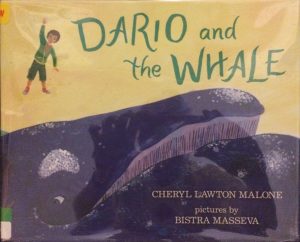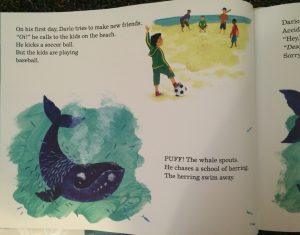Author: Cheryl Lawton Malone
Illustrator/ Photographer: Bistra Masseva
Publisher and Year: Albert Whitman and Company, 2016
Number of Pages: 29 pages
Genre: Fiction
This book tells of the tale of Dario’s adventures at the shore every spring. Dario and his mother move to the shore every spring so Dario’s mom is able to work. Dario, a boy of Brazilian culture, struggles to fit in except when he befriends a whale in the ocean. This story serves as a window for the intended audience because it tells of Dario’s struggles to fit in at the seashore due to his cultural differences. For example, when Dario went to the shore, no one wanted to play with him because he wanted to play soccer while the other boys were playing baseball.
In the beginning of the story, Dario’s mother holds the power because she brought Dario to the shore for her job. In addition, Dario does not fit in with the other children because his cultural likes are different from the other children’s likes. At the same time, the reader sees a parallel of a whale struggling to fit in with its atmosphere and fish in the ocean as well. The story follows the bonding of Dario and the whale throughout the rest of the story so that by the end of story, Dario gains power and confidence in realizing that he does indeed have a friend at the seashore. The story begins by stating that Dario and his mother come from a Brazilian background, which causes a struggle for Dario to fit in at the beach. Because his Brazilian traditions and culture is different from the other children at the beach, the other children do not want to interact with him. Regardless of Dario and the whale being different, they both manage to establish a positive friendship with each other. Through this book, my understanding of culture has not really changed from what I have already learned. Instead, it reiterates the importance and acceptance of diversity. It shows that though people have different cultures, it does not mean that all groups have to stay segregated. Dario and the Whale shows that people can have different interests and likes but can still be friends.
There is very little text while the images take up most the page to show the artwork speaks more than the text. The intermingling of Brazilian words with English honors two identities of Dario: Brazilian and American. For example, Dario holding a soccer ball stands for the importance of soccer to the Brazilian culture. At the same time, he wears the colors of the Brazilian flag, honoring the Brazilian culture. Dario’s struggles parallel with the whale’s struggle to fit in showing Dario is not alone in the struggle to feel welcomed. The text is next to the living figure in the story indicating that the character is completing what the text is saying. Colors and images are bright and cheerful to represent the excitement of Dario in finding a friend while also symbolizing the beautiful nautical colors of the ocean. This storybook conveys the messages that friends can be found in unlikely places, the ocean can connect people with nature, and differences among people make an individual special.


